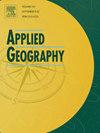系统规划与个人选择:城市医疗设施与患者群体的最佳匹配
IF 5.4
2区 地球科学
Q1 GEOGRAPHY
引用次数: 0
摘要
城市医疗设施规划面临的一个挑战是,尽管距离和成本增加,但病人往往会绕过低级医疗设施,选择高级医疗设施,而高级医疗设施人满为患,低级医疗设施利用率不足。这一现象及其挑战可能受到患者个人行为和地方政府城市医疗设施规划的影响。本文通过自上而下的规划和自下而上的个人选择两种方法,对患者人口与医疗设施的最佳匹配现象进行了研究。更具体地说,规划匹配从空间上将患者分配到最近的医疗机构,而选择匹配(包括多项式 logit 匹配或博弈论匹配)则根据患者的选择来优化医疗机构的选择。本研究以中国杭州市的 194 家医疗机构和 588 个住宅小区为试验平台,发现了以下问题:(1) 规划与个人选择之间的不一致性导致人口绕过某些设施;(2) 在各种匹配中,医疗服务水平与社区-设施距离之间的权衡是一致的;(3) 在距离和实际效用方面,系统规划优于个人选择,而在服务水平和间接效用方面则相反;(4) 存在某些阈值,超过这些阈值,这两种方法都不擅长,因此建议混合使用这两种方法。本文章由计算机程序翻译,如有差异,请以英文原文为准。
Systemic planning vs. individual Choice: The optimal matching for urban Healthcare Facilities and patient population
Urban healthcare facilities planning faces a challenge that patient population tend to bypass lower-level for higher-level healthcare facilities despite increased distance and cost along with overcrowding at high-level facilities and underutilization at low-level ones. This phenomenon and its challenges are presumably influenced by individual behaviors of patients and urban healthcare facilities planning by local governments. This paper examines this phenomenon through optimal matching of patient population to healthcare facilities in two approaches representing top-down planning and bottom-up individual choice. More specifically, planning matching spatially assigns the patients to the closest facilities and choice matching, including multinomial logit matching or game theoretic matching, optimally selects facilities based on patient choices. Using Hangzhou, China as a test bed with 194 healthcare facilities and 588 residential communities, this research has found that: (1) the inconsistency between planning and individual choice leads to population bypassing certain facilities; (2) the trade-offs between healthcare service level and community-facility distance are consistent across matchings; (3) systemic planning outperforms individual choice concerning distance and actual utility while the reverse holds true for service level and indirect utility; (4) certain thresholds exist beyond which neither approach excels, suggesting a mix of the two approaches.
求助全文
通过发布文献求助,成功后即可免费获取论文全文。
去求助
来源期刊

Applied Geography
GEOGRAPHY-
CiteScore
8.00
自引率
2.00%
发文量
134
期刊介绍:
Applied Geography is a journal devoted to the publication of research which utilizes geographic approaches (human, physical, nature-society and GIScience) to resolve human problems that have a spatial dimension. These problems may be related to the assessment, management and allocation of the world physical and/or human resources. The underlying rationale of the journal is that only through a clear understanding of the relevant societal, physical, and coupled natural-humans systems can we resolve such problems. Papers are invited on any theme involving the application of geographical theory and methodology in the resolution of human problems.
 求助内容:
求助内容: 应助结果提醒方式:
应助结果提醒方式:


